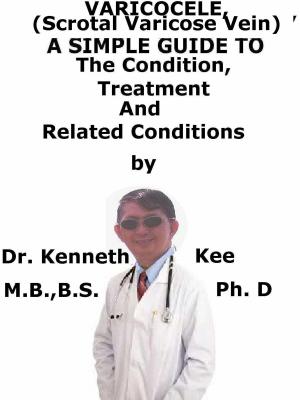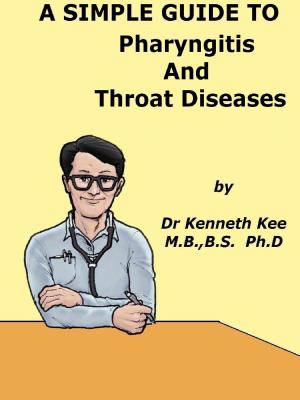Angioplasty, (Stent Dilatation) A Simple Guide To The Condition, Diagnosis, Treatment And Related Conditions
Nonfiction, Health & Well Being, Medical, Specialties, Internal Medicine, Cardiology, Health, Ailments & Diseases, Heart| Author: | Kenneth Kee | ISBN: | 9781370939008 |
| Publisher: | Kenneth Kee | Publication: | April 7, 2017 |
| Imprint: | Smashwords Edition | Language: | English |
| Author: | Kenneth Kee |
| ISBN: | 9781370939008 |
| Publisher: | Kenneth Kee |
| Publication: | April 7, 2017 |
| Imprint: | Smashwords Edition |
| Language: | English |
Angioplasty is a non-surgcal intervention to open narrowed or blocked coronary arteries that carry blood to the heart.
A coronary artery stent is a small, metal mesh tube that inflates to keep open a coronary artery.
A stent is often inserted during or instantly following angioplasty.
It assists to prevent the artery from closing up again.
A drug-eluting stent has medicine implanted in it that assists to prevent the artery from closing in the long term.
Angioplasty:
The patient may also be given medicine that calms down the patient, and blood thinning medicines to prevent a blood clot from developing.
The patient will stretch out on a padded table.
The doctor will place a flexible tube (catheter) through a surgical incision into an artery.
Occasionally the catheter will be inserted in the arm or wrist, or in the upper leg or groin area.
The patient will be conscious during the intervention.
The doctor will make use of live x-ray pictures to guide the catheter up into the heart and arteries.
A dye will be injected into the body to show up blood flow through the arteries.
This assists the doctor see any obstructions in the blood vessels that go to the heart.
A guide wire is passed into and across the obstruction.
A balloon catheter is thrust over the guide wire and into the blockage.
The balloon on the end is inflated (blown up).
This opens the obstructed vessel and reestablishes proper blood flow to the heart.
A wire stent (mesh tube) may then be inserted in this obstructed area.
The stent is placed along with the balloon catheter.
It widens when the balloon is inflated.
The stent is kept there to help maintain the artery open.
Reasons for the Intervention
Arteries can become constricted or obstructed by deposits called plaque.
This disorder is called atherosclerosis.
Angioplasty may be utilized to treat:
1. Obstruction in a coronary artery during or after a heart attack
2. Obstruction or constriction of one or more coronary arteries that places the patient at danger for a heart attack
3. Constricted blood vessels that decrease blood flow and produce persistent chest pain (angina) that medicines do not manage.
Not every blockage can be treated with angioplasty.
Some patients who have several obstructions or blockages in certain positions may require coronary bypass surgery.
Investigations before Angioplasty
An angiogram or angiography is a medical imaging method to look for any blocks, narrowing, dilatations and structural anomalies of heart blood vessels.
This intervention is used to identify the need for angioplasty.
This is a diagnostic investigation that is done after a patient displays atherosclerosis symptoms.
Using an angiogram, the arteries, veins, and the four chambers of the heart are observed by injecting radio-opaque dye (identified by X-rays) into the body.
The risks of angioplasty and stent insertion are:
1. Allergic reaction to the drug eluding stent, the stent material, or the x-ray dye
2. Bleeding or clotting in the area where the catheter was inserted
3. Blood clot
4. Clogging of the inside of the stent
5. Damage to a heart valve or blood vessel
6. Heart attack
7. Kidney failure (higher danger in people who already have kidney disorders)
8. Irregular heartbeat (arrhythmias)
9. Stroke (rare)
The Angioplasty Recovery Phase
Patients are often discharged on the same day or instantly next day after an angioplasty intervention.
They may go back to doing routine activities within a week of the intervention
1. Bathing/Getting Dressed – Same day after discharge
2. Walking (With Help) - 6 hours later
3. Cycling - 2 weeks later
4. Returning To Work (normally after 7-10 days)
5. Sex – 3 to 4 days later
6. Driving - 7-10 days later
TABLE OF CONTENT
Introduction
Chapter 1 Angioplasty
Chapter 2 Causes
Chapter 3 Symptoms
Chapter 4 Diagnosis
Chapter 5 Treatment
Chapter 6 Prognosis
Chapter 7 Coronary Heart Disease
Chapter 8 Atherosclerosis
Epilogue
Angioplasty is a non-surgcal intervention to open narrowed or blocked coronary arteries that carry blood to the heart.
A coronary artery stent is a small, metal mesh tube that inflates to keep open a coronary artery.
A stent is often inserted during or instantly following angioplasty.
It assists to prevent the artery from closing up again.
A drug-eluting stent has medicine implanted in it that assists to prevent the artery from closing in the long term.
Angioplasty:
The patient may also be given medicine that calms down the patient, and blood thinning medicines to prevent a blood clot from developing.
The patient will stretch out on a padded table.
The doctor will place a flexible tube (catheter) through a surgical incision into an artery.
Occasionally the catheter will be inserted in the arm or wrist, or in the upper leg or groin area.
The patient will be conscious during the intervention.
The doctor will make use of live x-ray pictures to guide the catheter up into the heart and arteries.
A dye will be injected into the body to show up blood flow through the arteries.
This assists the doctor see any obstructions in the blood vessels that go to the heart.
A guide wire is passed into and across the obstruction.
A balloon catheter is thrust over the guide wire and into the blockage.
The balloon on the end is inflated (blown up).
This opens the obstructed vessel and reestablishes proper blood flow to the heart.
A wire stent (mesh tube) may then be inserted in this obstructed area.
The stent is placed along with the balloon catheter.
It widens when the balloon is inflated.
The stent is kept there to help maintain the artery open.
Reasons for the Intervention
Arteries can become constricted or obstructed by deposits called plaque.
This disorder is called atherosclerosis.
Angioplasty may be utilized to treat:
1. Obstruction in a coronary artery during or after a heart attack
2. Obstruction or constriction of one or more coronary arteries that places the patient at danger for a heart attack
3. Constricted blood vessels that decrease blood flow and produce persistent chest pain (angina) that medicines do not manage.
Not every blockage can be treated with angioplasty.
Some patients who have several obstructions or blockages in certain positions may require coronary bypass surgery.
Investigations before Angioplasty
An angiogram or angiography is a medical imaging method to look for any blocks, narrowing, dilatations and structural anomalies of heart blood vessels.
This intervention is used to identify the need for angioplasty.
This is a diagnostic investigation that is done after a patient displays atherosclerosis symptoms.
Using an angiogram, the arteries, veins, and the four chambers of the heart are observed by injecting radio-opaque dye (identified by X-rays) into the body.
The risks of angioplasty and stent insertion are:
1. Allergic reaction to the drug eluding stent, the stent material, or the x-ray dye
2. Bleeding or clotting in the area where the catheter was inserted
3. Blood clot
4. Clogging of the inside of the stent
5. Damage to a heart valve or blood vessel
6. Heart attack
7. Kidney failure (higher danger in people who already have kidney disorders)
8. Irregular heartbeat (arrhythmias)
9. Stroke (rare)
The Angioplasty Recovery Phase
Patients are often discharged on the same day or instantly next day after an angioplasty intervention.
They may go back to doing routine activities within a week of the intervention
1. Bathing/Getting Dressed – Same day after discharge
2. Walking (With Help) - 6 hours later
3. Cycling - 2 weeks later
4. Returning To Work (normally after 7-10 days)
5. Sex – 3 to 4 days later
6. Driving - 7-10 days later
TABLE OF CONTENT
Introduction
Chapter 1 Angioplasty
Chapter 2 Causes
Chapter 3 Symptoms
Chapter 4 Diagnosis
Chapter 5 Treatment
Chapter 6 Prognosis
Chapter 7 Coronary Heart Disease
Chapter 8 Atherosclerosis
Epilogue















